Comments / Questions (212)
![]() Rosi Grassl wrote:
Rosi Grassl wrote:
Hallo 🙋♀️ Ich stricke dieses Model in L. Und hab beim Rückenteil ein Problem beim Teil 1. ich hab das alles in Rechte Maschen gestrickt, jetzt hab ich es fertig und soll 96 Maschen aufnehmen. Aber ich hab so Knötchen an der Seite, durch das Rechts gestrickte und das ergibt aber beim aufnehmen keine 96. höchstens 56 🤔 Oder hätte ich die Randmaschen anders stricken müssen? Was hab ich verkehrt gemacht? Lg Rosi
11.11.2025 - 19:50DROPS Design answered:
Liebe Frau Grassi, diese Maschen vom 2. Teil sollen an der rechten Seite (bei der Vorderseite gesehen, siehe Skizze) aufgenommen, aber nicht nur in die Krausrippen aber auch dazwischen damit es genügend Maschen sind. Viel Spaß beim Stricken!
21.11.2025 - 14:54
![]() Sylvie wrote:
Sylvie wrote:
Bonjour. Est ce possible de faire ce modèle avec un autre point que le point mousse, par exemple le point de riz ou de blé ? Merci pour votre aide
09.07.2025 - 01:18DROPS Design answered:
Bonjour Sylvie, l'echantillon pour le point mousse est different en hauteur, donc dans ce genre de pull le changement de point va etre assez complique. Bon tricot!
09.07.2025 - 07:55
![]() Barbara Holbek wrote:
Barbara Holbek wrote:
Jeg vil gerne strikke DROPS jakke med dominoruder i Fabel. Model FA-075 Strikker jeg som det står på banderolen passer det med 24m x 32p =10x10. Strikker jeg som det står i opskriften 24m x 48p passer det i bredden med bliver alt for lang. Hvad nu???
19.06.2025 - 14:14DROPS Design answered:
Hei Barbara. Når du skal strikke denne jakken, må du følge strikkefastheten som er oppgitt i oppskriften. Husk at den er oppgitt med retstrik (48 pinder retstrik), mens det på banderolen er oppgitt i glattstrikk. mvh DROPS Design
23.06.2025 - 11:21
![]() Daniela wrote:
Daniela wrote:
Ich habe da ein problem beim rechten vorderteil eine markierungsfaden und dann eine masch abnehmen , aber wo wir die masche abgenommen? Auf der vordeeseitet vor dem Markierunfsfaden und auf der rückseite auch vor dem markierungsfaden
16.08.2022 - 19:20DROPS Design answered:
Liebe Daniela, beim linken Vorderteil, Teil-1 haben Sie am Anfang den Hinreihen abgenommen, beim rechten Vorderteil, Teil-1, nehmen Sie am Ende den Hinreihen zu (so sind beide Vorderteile verkehrt). Viel Spaß beim stricken!
17.08.2022 - 08:08
![]() Marie MALLET wrote:
Marie MALLET wrote:
Bonjour dans la partie DOMINO faut il passer la m qui est avant le marqueur au dessus des 3 m ens à l'endroit? Au niveau du Rang 5 : Tricoter jusqu'à 1 m avant le marqueur, 3 m ens à l'end, tricoter les mailles restantes à l'endroit
03.01.2022 - 19:42DROPS Design answered:
Bonjour Mme Mallet, le marqueur doit être dans la maille centrale = celle au milieu du domino, ainsi, au rang 2, vous glissez la maille avant le marqueur, tricotez la maille avec le marqueur (= maille centrale) ensemble avec la maille suivante et passez la maille glissée par-dessus la maille tricotée. Au rang 5, vous tricotez jusqu'à ce qu'il reste 1 maille avant celle avec le marqueur, tricotez la maille avant celle avec le marqueur + celle avec le marqueur + la suivante ensemble à l'endroit (vous diminuez 2 mailles). Bon tricot!
04.01.2022 - 07:15
![]() Uschi wrote:
Uschi wrote:
Danke für die Antwort! Ja, das war genau das Detail was in der Anleitung fehlt. Aber ich habe mir ein anderes Design ausgesucht. 194—27 das sieht auch super aus! Vielleicht habe ich später wieder fragen dazu.🙈danke schon im voraus!! LG Uschi
10.05.2021 - 12:11
![]() Uschi Geisler wrote:
Uschi Geisler wrote:
Ich habe festgestellt, dass die Frage die ich habe schon sehr oft gestellt wurde,aber leider wurde sie nicht wirklich beantwortet. Wo wird der Markierungsfaden gesetzt?? Vielen Dank im Voraus!
08.05.2021 - 14:34DROPS Design answered:
Liebe Frau Geisler, könnte Ihnen die vorrige Antwort helfen oder stricken Sie eine andere Größe/meinen Sie etwas anderes?
10.05.2021 - 10:53
![]() Uschi wrote:
Uschi wrote:
2. R (= Vorderseite): re. bis noch 1 M. vor dem Markierungsfaden zu stricken ist, Das ist ganz am Anfang. Ich habe 159 Maschen aufgenommen. Doch wo sollte ich denn den Markierungsfaden setzen? LG Uschi
08.05.2021 - 13:35DROPS Design answered:
Liebe Uschi, die Markierung legen Sie in die mittleren Masche - Größe S mit 159 Rückenteil/rechtes Vorderteil, Teil-2 und Rûckenteil/linkes Vorderteil, Teil-2 (79 M, 1 M mit Markierung, 79 M). Viel Spaß beim stricken!
10.05.2021 - 10:52
![]() Carole wrote:
Carole wrote:
Bonjour je n'ai pas compris par exemple pour le dos si je dois commencer les diminutions des le 1 er rang ou faire 2 cms point mousse et ne faire les diminutions qu'apres ces 2cms je vous remercie
04.01.2021 - 03:11DROPS Design answered:
Bonjour Carole, au tout début du dos, tricotez d'abord 2 cm point mousse sur toutes les mailles, placez ensuite un marqueur au milieu et continuez au point mousse en commençant les diminutions comme indiqué aux rangs 1 à 10. Bon tricot!
05.01.2021 - 10:09
![]() Rita Fernandes wrote:
Rita Fernandes wrote:
Hjælp mig! Jeg har lavet ryg del 1 to gang og den bliver ved med at bliver kun 17cm! Med forstyr bliver ca. 20 cm! Jeg ved ikke hvad er problemet.
21.12.2020 - 21:31DROPS Design answered:
Hej Rita, har du 24 masker i bredden OG 48 pinde i højden på 10x10 cm?
22.12.2020 - 09:39
Domino Effect#dominoeffectjacket |
|
 |
 |
Knitted DROPS jacket with domino squares in ”Fabel”. Size S - XXXL.
DROPS 111-1 |
|
|
DOMINO SQUARE: 1 Domino square: = 159-177-193-209-227-245sts: Row 1 (= WS): K all sts. Row 2 (= RS): work row until 1 st before marker, slip 1 st as if to K, K2 tog, psso, work remaining sts on row. Row 3: K all sts. Row 4: Like row 2. Row 5: Work row until 1 st before marker, K3 tog, work remaining sts on row. Row 6: Like row 2. Row 7: K all sts. Row 8: Like row 2. Row 9: K all sts. Row 10: Like row 2. Repeat row 1 to 10 until there is 1 st left on needle. Cut the thread and pull through remaining st. HALF DOMINO SQUARE: 1 Half Domino square = 133-149-161-173-189-201 sts: Row 1 (= WS): Work row until 1 st remain, slip this st on stitch holder-1. Row 2 (= RS): Work row until 1 st before marker, slip 1 st as if to K, K2 tog, psso, work sts on row until 1 st remain, slip this st on stitch holder-2. Repeat row 1 and 2 until there is 1 st left on needle and 33-37-40-43-47-50 sts on each stitch holder. QUARTER DOMINO SQUARE: 1 quarter Domino square: Row 1 (= WS): K all sts, with 10 front band sts in P sts. Row 2 (= RS): P 10 front band sts, K2 tog, work row until 1 st remain, slip this st on stitch holder-1. Repeat row 1 and 2 until there are 11 sts left on needle (includes 10 front band sts) and 33-37-40-43-47-50 sts on stitch holder-1. BUTTONHOLES: Make buttonholes on right front band. 1 buttonhole = bind off 5th st from mid front and cast on 1 new st on return row. Make buttonholes when piece measures: SIZE S: 23, 28, 34 and 40 cm / 9", 11", 13⅜" and 15¾" SIZE M: 25, 31, 37 and 44 cm / 9¾", 12¼", 14½" and 17¼" SIZE L: 27, 34, 41 and 48 cm / 10⅝", 13⅜", 16⅛" and 19" SIZE XL: 29, 36, 44 and 52 cm / 11⅜", 14¼", 17¼" and 20½" SIZE XXL: 31, 37, 43, 49 and 56 cm / 12¼", 14½", 17", 19¼" and 22" SIZE XXXL: 33, 39, 45, 51 and 58 cm / 13", 15¼", 17¾", 20" and 22¾" -------------------------------------------------------- -------------------------------------------------------- BACK PIECE, PART 1: Worked in garter st throughout, i.e. K all rows. Cast on 129-143-157-171-185-199 sts on needle size 3 mm / US 2or3 with Fabel. Work 2 cm / ¾" garter st on all sts. Insert a marker in the middle st (= mid back). Continue in garter st, AT THE SAME TIME dec 1 st (by K2 tog) each side as follows: Row 1 (= RS): dec 1 st each side. Row 2 (= WS): K all sts. Row 3: dec 1 st each side. Row 4: dec 1 st each side. Row 5: dec 1 st each side. Row 6: K all sts. Row 7: dec 1 st each side. Row 8: dec 1 st each side. Row 9: dec 1 st each side. Row 10: K all sts. Repeat from row 1 to 10 a total of 9-10-11-12-13-14 times = 3 sts left on needle. Work next row from RS as follows: slip 1 st as if to K, K2 tog, psso = 1 st left on needle. Cut the thread and pull through remaining st. Piece now measures approx 21-23-25-27-29-31 cm / 8¼"-9"-9¾"-10⅝"-11⅜"-12¼" from casting on row to the top of square. LEFT FRONT PIECE PART 1: Cast on 75-82-89-96-103-110 sts (includes 10 front band sts towards mid front) on needle size 3 mm / US 2or3 with Fabel. Work 2 cm / ¾" garter st with 10 front band sts in P sts towards mid front – P front band sts on every row throughout. Insert a marker inside the 10 front band sts. Continue in garter st, AT THE SAME TIME dec 1 st (by K2 tog) at the side as follows: Row 1 (= RS): dec 1 st at the side. Row 2 (= WS): K all sts (continue to P front band sts). Row 3: dec 1 st at the side. Row 4: dec 1 st at the side. Row 5: dec 1 st at the side. Row 6: K all sts (continue to P front band sts). Row 7: dec 1 st at the side. Row 8: dec 1 st at the side. Row 9: dec 1 st at the side. Row 10: K all sts (continue to P front band sts). Repeat from row 1 to 10 a total of 9-10-11-12-13-14 times = 12 sts left on needle. Work next row from RS as follows: K2 tog, cut thread and pull through st created by K2 tog, slip the remaining 10 front band sts on a stitch holder. Piece now measures approx 21-23-25-27-29-31 cm / 8¼"-9"-9¾"-10⅝"-11⅜"-12¼" from cast on row to the top of square. RIGHT FRONT PIECE PART 1: Like left front piece, but mirrored. BACK PIECE/RIGHT FRONT PIECE PART 2: Pick up 79-88-96-104-113-122 sts along the side on right front piece (part 1), beg inside front band sts on stitch holder and pick up sts to where the dec at the side of Part 1 started (i.e. 2 cm / ¾" at the bottom of front piece and back piece are left "open" and will be sewn tog later). Cast on 1 st between front piece and back piece, and pick up 79-88-96-104-113-122 sts along the right side on back piece (part 1) up to the point (= mid back) = a total of 159-177-193-209-227-245 sts on needle. Insert a marker in the middle st (= mid side). Now work Domino square, see above. BACK PIECE/LEFT FRONT PIECE PART 2: Beg at the point mid back on back piece. Pick up 79-88-96-104-113-122 sts along the side to where the dec at the side on Part 1 started (i.e. 2 cm / ¾" at the bottom of front piece and back piece are left "open" and will be sewn tog later). Cast on 1 st between back piece and front piece, and pick up 79-88-96-104-113-122 sts along the side on front piece up to front band sts on stitch holder = a total of 159-177-193-209-227-245 sts on needle. Insert a marker in the middle st (= mid side). Now work Domino square. BACK PIECE PART 3: Pick up 66-74-80-86-94-100 sts (from RS) from the point at the top of Domino square at the right side and down along the edge to where the 2 Domino squares meet mid back, pick up 1 st between the 2 squares and pick up 66-74-80-86-94-100 sts along the side to the top of the Domino square on the left side = a total of 133-149-161-173-189-201 sts on needle. Insert a marker in the middle st. Now work Half Domino square – see above. BACK PIECE PART 4: Keep the 1 st on needle and slip sts from stitch holder-1 and stitch holder-2 back on needle. K 1 row, AT THE SAME TIME pick up 28-30-34-40-47-55 sts evenly among the sts slipped back on needle = 95-105-115-127-142-156 sts. Insert a marker in piece, now measure piece from here. Continue in garter st back and forth on needle on all sts. When piece measures approx 6 cm / 2⅜" from marker bind off 3-3-3-4-4-4 sts each side for armhole and bind off to shape the armhole each side at the beg of every row: 3 sts 0-0-0-1-2-3 times, 2 sts 0-2-4-4-5-6 times and 1 st 2-2-2-3-4-5 times = 85-87-89-91-94-96 sts left on needle. Continue in garter st back and forth on needle until piece measures 23-24-25-26-27-28 cm / 9"-9½"-9¾"-10¼"-10⅝"-11" from marker. Now bind off the middle 21-23-25-27-30-32 sts for neck and complete each shoulder separately. Bind off 1 st on neckline on every other row a total of 3 times = 29 sts left on shoulder. Bind off when piece measures 25-26-27-28-29-30 cm / 9¾"-10¼"-10⅝"-11"-11⅜"-11¾" from marker, piece now measures a total of approx 65-70-75-80-85-90 cm / 25½"-27½"-29½"-31½"-33½"-35½". RIGHT FRONT PIECE PART 3: Remember BUTTONHOLES – see above. Slip 10 front band sts back on needle. Pick up (from RS) 1 st between front band and the point at the side of Domino square, then pick up 66-74-80-86-94-100 sts along the side of the Domino square up to the point at the side of jacket = 77-85-91-97-105-111 sts on needle. Insert a marker in the st between front band and Domino square. Continue to P front band sts on every row. Now work Quarter Domino square – see above. RIGHT FRONT PIECE PART 4: Keep the 11 sts on needle and slip sts from stitch holder back on needle. K 1 row, AT THE SAME TIME pick up 14-16-17-20-22-27 sts evenly among sts slipped back on needle = 58-64-68-74-80-88 sts (includes 10 front band sts). Insert a marker, and now measure piece from here. Continue in garter st back and forth on needle with front band sts as before. When piece measures approx 6 cm / 2⅜" from marker bind off for armhole at the side as described for back piece = 53-55-55-56-56-58 sts. Continue until piece measures 25-26-27-28-29-30 cm / 9¾"-10¼"-10⅝"-11"-11⅜"-11¾" from marker. Now bind off 29 sts from shoulder towards the neckline = 24-26-26-27-27-29 sts left on needle for collar. Continue in garter st back and forth on needle on collar sts with front band sts as before. When collar measures approx 6-7-7-8-9-9 cm / 2⅜"-2¾"-2¾"-3⅛"-3½"-3½" from shoulder, bind off. LEFT FRONT PIECE PART 3 AND 4: Like right front piece, but mirrored and without buttonholes. SLEEVE: Worked back and forth on needle. Cast on 56-58-60-62-64-68 sts (includes 1 edge st each side) on needle size 3 mm / US 2or3 with Fabel. Work garter st until piece measures approx 5 cm / 2". Work 5 rows stockinette st and now continue in reverse stockinette st. When piece measures 8 cm / 3⅛" inc 1 st each side and repeat the inc on every 3.5-3-2.5-2-1.5-1.5 cm / 1¼"-1⅛"-⅞"-¾"-½"-½" a total of 12-14-15-18-21-22 times = 80-86-90-98-106-112 sts. When piece measures 50-49-49-48-48-46 cm / 19¾"-19¼"-19¼"-19"-19"-18" (less for the larger sizes because of longer sleeve cap and wider shoulder) bind off for sleeve cap each side at the beg of every row: 3 sts 1 time, 2 sts 5-5-5-5-5-6 times and 1 st 1-2-4-6-7-7 times, then bind off 2 sts each side until piece measures approx 57-57-58-58-59-59 cm / 22½"-22½"-22¾"-22¾"-23¼"-23¼", now bind off 3 sts each side 1 time. Bind off remaining sts. Piece measures approx 58-58-59-59-60-60 cm / 22¾"-22¾"-23¼"-23¼"-23⅝"-23⅝". ASSEMBLY: Sew side seams and sew tog the edge (= 2 cm / ¾" garter st) towards bottom edge each side. Sew in outer loops of sts. Sew sleeve seam inside 1 edge and set in sleeves. Sew collar tog mid back and sew to neckline. Sew on buttons. |
|
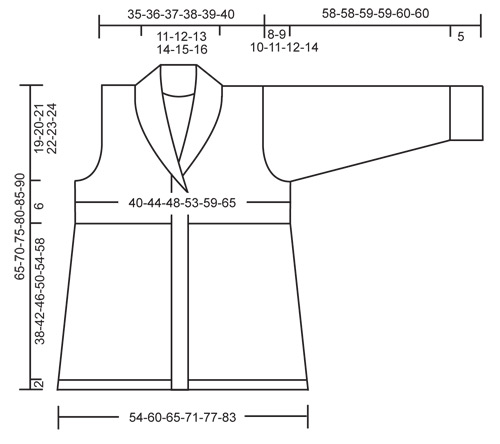 |
|
 |
|
Have you finished this pattern?Tag your pictures with #dropspattern #dominoeffectjacket or submit them to the #dropsfan gallery. Do you need help with this pattern?You'll find 22 tutorial videos, a Comments/Questions area and more by visiting the pattern on garnstudio.com. © 1982-2025 DROPS Design A/S. We reserve all rights. This document, including all its sub-sections, has copyrights. Read more about what you can do with our patterns at the bottom of each pattern on our site. |
|















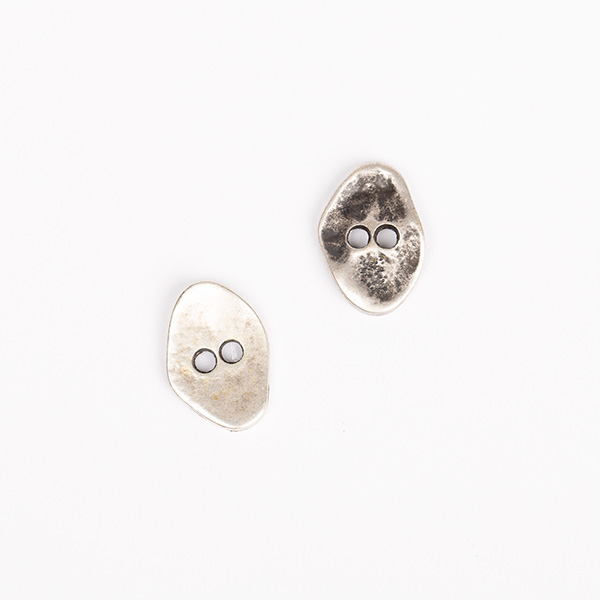






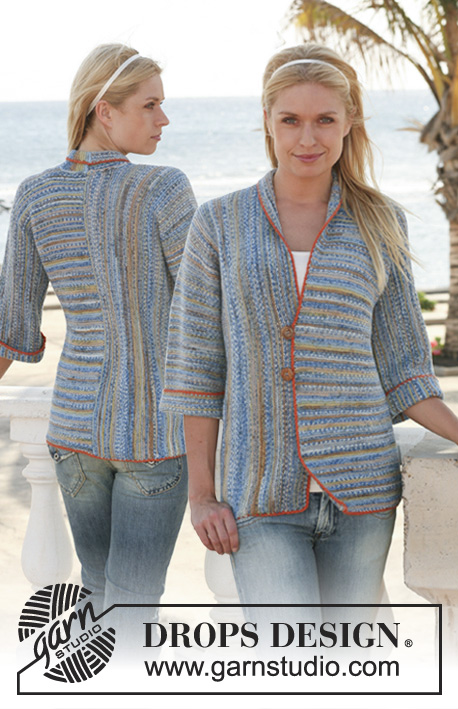




































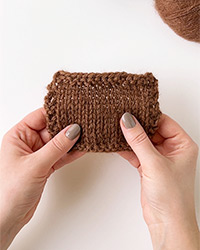
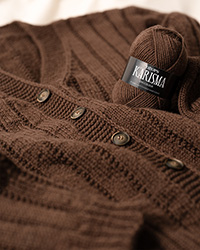
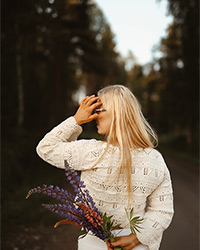

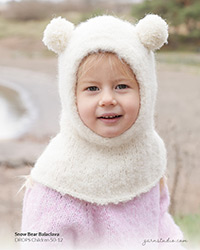
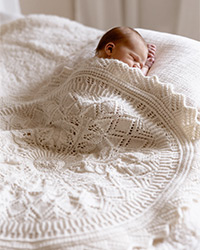
Post a comment to pattern DROPS 111-1
We would love to hear what you have to say about this pattern!
If you want to leave a question, please make sure you select the correct category in the form below, to speed up the answering process. Required fields are marked *.